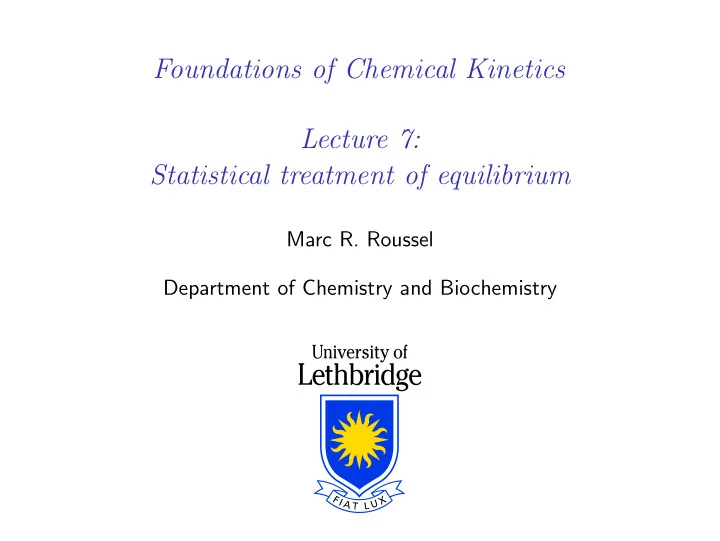

Foundations of Chemical Kinetics Lecture 7: Statistical treatment of equilibrium Marc R. Roussel Department of Chemistry and Biochemistry
Equilibrium: A statistical picture For a reaction A ⇋ B, ε ∆ε 0 A B both together
Equilibrium: A statistical picture (continued) ◮ There is a Boltzmann distribution for both sets of molecular states together. ◮ By summing the probabilities of the states belonging to one of the two chemical identities and multiplying by the total number of molecules ( N ), we get the average number of molecules which are of the corresponding type. P ( A ) = 1 � − ǫ a � � exp Q k B T a ∴ N A = N � − ǫ a � � exp Q k B T a � − ǫ b � N B = N � and exp Q k B T b
Equilibrium: A statistical picture (continued) ◮ It is tempting to conclude that the sums � a exp( − ǫ a / k B T ) and � b exp( − ǫ b / k B T ) are the partition functions of A and B. ◮ Normally, the partition function of a molecule is computed by setting the zero of energy at the ground state. (Think about our computation of the partition function of the harmonic oscillator.) ◮ To deal with both molecular states together, we need to add ∆ ǫ 0 , the difference between the ground-state energies of A and B, to the energies of B. This has the effect of multiplying the partition function of B by exp( − ∆ ǫ 0 / k B T ). ◮ Thus, � a exp( − ǫ a / k B T ) = Q A and � b exp( − ǫ b / k B T ) = Q B exp( − ∆ ǫ 0 / k B T ).
Equilibrium: A statistical picture (continued) ◮ The expected numbers of molecules of A and B are therefore N A = NQ A / Q N B = ( NQ B / Q ) exp( − ∆ ǫ 0 / k B T ) ◮ The equilibrium constant is K = N B / N A , or � − ∆ ǫ 0 � K = Q B exp Q A k B T
General case: a A + b B ⇋ c C + d D K = Q c C Q d � − ∆ E 0 � N − ∆ n exp D Q a A Q b k B T B where � � ◮ ∆ ǫ 0 = c ǫ ( C ) + d ǫ ( D ) a ǫ ( A ) + b ǫ ( B ) − 0 0 0 0 ◮ ∆ n = c + d − ( a + b ) (difference of stoichiometric coefficients) ◮ N is the number of molecules (dimensionless). ◮ The translational partition function depends on V . N and V are chosen to be consistent with the standard state. Example: For p ◦ = 1 bar at 25 ◦ C, p / RT = 40 . 34 mol m − 3 , so we could pick V = 1 m 3 and N = 40 . 34 × 6 . 022 × 10 23 = 2 . 429 × 10 25 .
Recommend
More recommend